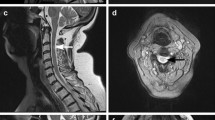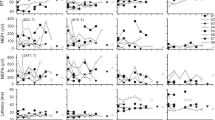Abstract
This randomised, single-blind, placebo-controlled study involved 20 patients with chronic upper motoneuron syndrome due to ischemic cerebrovascular lesions, selected in order to ensure the greatest possible homogeneity in terms of the severity of the syndrome. All of them were treated with protirelin tartrate 4 mg/die i.m. The study included semiquantitative clinical evaluations of neurological examinations, with particular attention being paid to weakness and spasticity. These were accompanied by neurophysiological evaluations (F-waves, magnetic motor evoked potentials). Extended biohumoral investigations of possible side effects were also carried out. The results indicate a slight but statistically significant absolute improvement in spasticity and muscular strength following protirelin tartrate, especially in the lower limbs; at the same time, the drug also proved to be capable as favourably modifying the response of the biceps femoris muscle to transcranial magnetic stimulation (reappearance, increased amplitude and a reduction in the threshold of motor evoked potentials). The drug was generally well tolerated.
Sommario
Abbiamo condotto uno studio in cieco-singolo, randomizzato, controllato con placebo, su 20 pazienti affetti da sindrome cronica del motoneurone superiore, esito di lesione vascolare ischemica cerebrale. Il gruppo di pazienti era selezionato in funzione della massima possibile omogeneità quanto alla gravità della sindrome e trattato per 2 settimane con protirelina tartrato 4 mg IM/die. Lo studio comprendeva valutazioni cliniche semiquantitative dell'esame neurologico, con particolare riguardo all'ipostenia ed alla spasticità. A queste si affiancavano valutazioni neurofisiologiche (studio dell'onda F e dei potenziali evocati motori magnetici). Venivano effettuate estese indagini bioumorali circa i possibili effetti collaterali. I risultati indicano un miglioramento lieve sul piano assoluto, ma statisticamente significativo, della spasticità e della forza muscolare dopo protirelina tartrato, specie per l'arto inferiore. Contemporaneamente, il farmaco si dimostrava capace di modificare in senso favorevole la risposta allo stimolo magnetico transcranico nel muscolo bicipite femorale (ricomparsa, aumento d'ampiezza e diminuzione di soglia del potenziale evocato motore). Esso si dimostrava complessivamente ben tollerato.
Similar content being viewed by others
References
Agnoli A., Fioravanti M., Napoleoni A., Formisano R.:Neuropsychological and clinical effects of protirelin tartrate on the recovery from cerebrovascular accidents. In: Agnoli A., Delwaide P.J., Prange A.J., Scapagnini U. (Eds.), Protirelin Tartrate (TRH-T). Pharmacological and clinical studies. Recent advances and perspectives. New prospects in neuropharmacology: 1, John Libbey, London-Paris, pp. 165–177, 1988.
Ashworth B.:Preliminary trial of carisoprodol in multiple sclerosis. Practitioner 192:540–542, 1964.
Barker A.T., Jalinous T., Freeston J.L.:Noninvasive magnetic stimulation of human motor cortex. Lancet i:1106–1107, 1987.
Berardelli A., Inghilleri M., Manfredi M., Zamponi A., Cecconi V., Dolce G.:Cortical and cervical stimulation after hemispheric infarction. J. Neurol. Neurosurg. Psychiatry 50:861–865, 1987.
Cantello R., Gianelli M., Bettucci D., et al.:Parkinson's disease rigidity: magnetic motor evoked potentials in a small hand muscle. Neurology 41:1149–1456, 1991.
Caramia M.D., Cicinelli P., Paradiso C., et al.:“Excitability” changes of muscular responses to magnetic brain stimulation in patients with central motor disorders. Electroencephalogr. Clin. Neurophysiol. 81:243–250, 1991.
Delwaide P.J., Schoenen J.:TRH inihibits flexor reflexes in man. Neurology 35 (Suppl. 1):71, 1985.
Delwaide P.J., Schoenen J.:The effects of TRH on F waves recorded from antagonistic muscles in man. Ann. Neurol. 18:366–367, 1985.
Delwaide P.J.:TRH-T in the symptomatic treatment of the upper motoneurone syndrome: achievement and prospect. In: Agnoli A., Delwaide P.J.; Prange A.J., Scapagnini U. (Eds.), Protirelin Tartrate (TRH-T). Pharmacological and clinical studies. Recent advances and perspectives. New prospects in neuropharmacology: 1, John Libbey, London-Paris, pp. 179–184, 1988.
Eandi M., Signorile F., Rubinetto M.P., Genazzani E.:Evaluation of efficacy and tolerability of protirelin-tartrate. Results of a polycentric study in Italy. Arch. Gerontol. Geriatr. 12 (Suppl. 2):191–200, 1991.
Eisen A., Odusote K.:Amplitude of the F wave: a potential means of documenting spasticity. Neurology 29:1306–1309, 1979.
Engel W.K., Siddique T., Nicoloff J.:Effect on weakness and spasticity in amyotrophic lateral sclerosis of thyrotropin releasing hormone. Lancet ii:73–75, 1983.
Faden A.J., Jacobs T.P., Holaday J.M.:Thyrotropin-releasing Hormone improves neurologic recovery after spinal trauma in cats. New Engl. J. Med. 305:1063–1067, 1981.
Formisano R., Fioravanti M., Interligi M., Ramelli L., Agnoli A.:Clinical effects of TRH-T on post-traumatic symptomatology. In: Agnoli A., Delwaide P.J., Prange A.J., Scapagnini U. (Eds.), Protirelin Tartrate (TRH-T). Pharmacological and clinical studies. Recent advances and perspectives. New prospects in neuropharmacology: 1, John Libbey, London-Paris, pp. 143–151, 1988.
Fornarelli M., Delwaide P.J.:TRH and the upper motoneuron syndrome in man. In: Neuropeptides in human therapy: pharmacology and clinical perspectives of TRH-T. TB Today, suppl. 4: pp. 59–64, 1988.
Heald A., Bates D., Cartlidge N.E.F., French J.M., Miller S.:Longitudinal study of central conduction time following stroke. 1. Natural history of central motor conduction. Brain 116:1355–1370, 1993.
Heald A., Bates D., Cartlidge, N.E.F., French J.M., Miller S.:Longitudinal study of central conduction time following stroke. 2. Central motor conduction measured within 72 h after stroke as a predictor of functional outcome at 12 months. Brain 116:1371–1386, 1993.
Hess C.W., Mills K.R., Murray N.M.F.:Responses in small hand muscles from magnetic stimulation of the human brain. J. Physiol. (Lond.) 338:397–419, 1987.
Kimura J.:Electrodiagnosis in diseases of nerve and muscle: principles and practice. Edition 2. F.A. Davis Company, Phildelphia, 1989, pp. 709.
Mitsuma T., Nogimori T.:Alterations in endocrine function in association with 3-week continous administration of TRH-T in patients with spinocerebellar degeneration. J. New Remed. & Clin. 32:1147, 1983.
Nappi G., Sandrini G.:Malattie cerebro-vascolari. In: Pinelli P. (ed.), Neurologia. Principi di diagnostica e terapia. Milano: Casa Editrice Ambrosiana pp. 641–669, 1985.
Nicoll R.A.:Excitatory action of TRH on spinal motoneurones. Nature. (Lond.) 265:242–243, 1977.
Nistri A., Lacey G.:Mechanism of action of TRH (Protirelin-T) on spinal motoneurones: an electro-physiological study. In: Agnoli A., Delwaide P.J., Prange A.J., Scapagnini U. (Eds.), Protirelin Tartrate (TRH-T). Pharmacological and clinical studies. Recent advances and perspectives. New prospects in neuropharmacology: 1, John, Libbey, London-Paris, pp. 5–14, 1988.
Panizza M., Nillson J., Santoro L.:Efficacia del TRH nella paraparesi spastica. [Abstract]. Atti Riunione Primaverile Società Italiana di Elettroencefalografia e Neurofisiologia Clinica. Verona, p. 100, 1900.
Pinelli P., Pisano F.:An EMG study of the effects of TRH-T in degenerative progressive motor-neuronopathies and multifocal neuropathy. In: Neuropeptides in human therapy: pharmacology and clinical perspectives of TRH-T. TB Today, suppl. 4: pp. 5–80, 1988.
Rossini P.M., Marciani M.G., Caramia M., et al.:Nervous propagation along “central” motor pathways in intact man: characteristics of motor responses to “bifocal” and “unifocal” spine and scalp non-invasive stimulation. Electroencephalogr. Clin. Neurophysiol. 61:272–286, 1985.
Rossini P.M., Desiato M.T., Caramia M.D.:Age-related changes of motor evoked potentials in healthy humans: non-invasive evaluation of central and peripheral motor tract excitability and conductivity. Brain Res. 593:14–19, 1992.
Sano K.:Prolirelin Tartrate (TRH-T) in the treatment of disturbances of consciousness. In: Agnoli A., Delwaide P.J., Prange A.J., Scapagnini U. (Eds.), Protirelin Tartrate (TRH-T). Pharmacological and clinical studies. Recent advances and perspectives. New prospects in neuropharmacology: 1, John Libbey, London-Paris, pp. 153–164, 1988.
Sharif N.A.:Diverse roles of thyrotropin-releasing hormone in brain, pituitary and spinal function. Trends Pharmacol. Sci. 6:119–122, 1985.
Shrewsbury-Gee J., Lye R.H., Latham A., Slater P.:The effects of TRH analogues on cerebral ischaemia produced by middle cerebral artery occlusion in the rat. Exp. Brain Res. 70:342–350, 1988.
Sobue I., Takayanagi T., Nakanishi T., et al.:Controlled trial of thyrotropin releasing hormone tartrate in ataxia of spinocerebellar degenerations. J. Neurol. Sci. 61:235–238, 1983.
Sobue I., Yamamoto H., Konagaya M., Iida M., Takayanagi T.:Effect of thyrotropin releasing hormone on ataxia of spinocerebellar degeneration. Lancet ii:418–419, 1980.
Villardita C., Cartoni P., Cinanni G., Nicoletti F.:Protirelin tartrate in the treatment of symptomatology following acute cerebrovascular insufficiency. Curr. Ther. Res. 38:404–413, 1985.
Author information
Authors and Affiliations
Rights and permissions
About this article
Cite this article
Civardi, C., Naldi, P., Cantello, R. et al. Protirelin tartrate (TRH-T) in upper motoneuron syndrome: a controlled neurophysiological and clinical study. Ital J Neuro Sci 15, 395–406 (1994). https://doi.org/10.1007/BF02339903
Received:
Accepted:
Issue Date:
DOI: https://doi.org/10.1007/BF02339903




